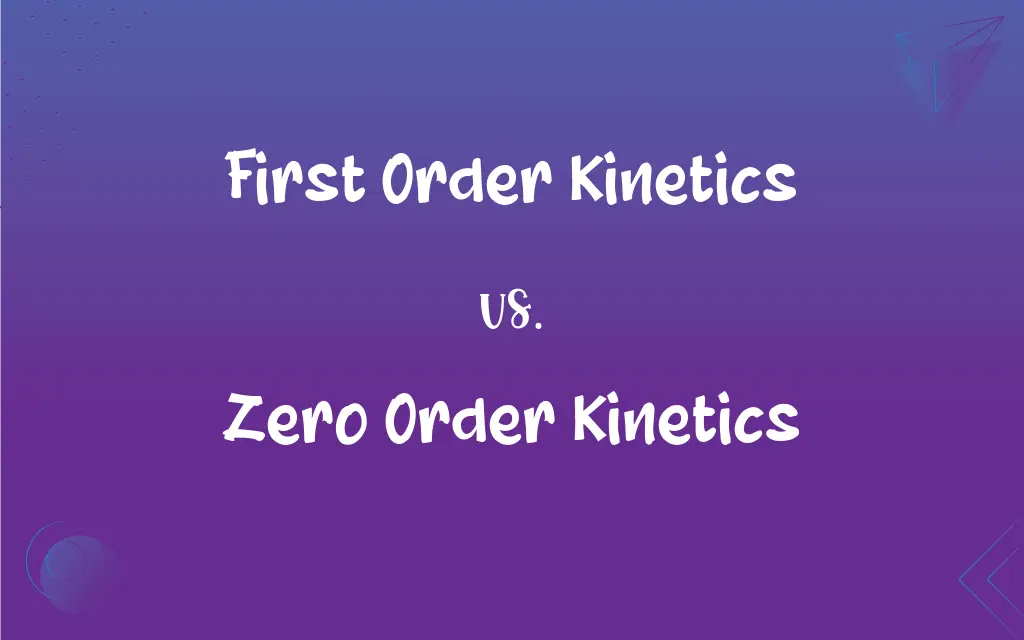First Order Kinetics vs. Zero Order Kinetics: What's the Difference?
Edited by Aimie Carlson || By Janet White || Published on March 9, 2024
First order kinetics describes a reaction rate that depends linearly on the concentration of one reactant, while zero order kinetics describes a reaction rate that is independent of the reactant's concentration.

Key Differences
First order kinetics and zero order kinetics are two types of reaction rate laws that describe how the rate of a chemical reaction depends on the concentration of the reactants. In first order kinetics, the rate of reaction is directly proportional to the concentration of one reactant. Zero order kinetics, on the other hand, describes a situation where the reaction rate is constant and does not depend on the concentration of the reactant. This occurs when the reaction rate is limited by factors other than the concentration of the reactants, such as the availability of active sites on a catalyst or the intensity of light in a photochemical reaction.
The mathematical expressions for first order and zero order kinetics differ significantly. For a first order reaction, the rate law is expressed as rate = k[A], where k is the rate constant and [A] is the concentration of the reactant. The integrated rate law for a first order reaction is ln[A] = -kt + ln[A]₀, where [A]₀ is the initial concentration of the reactant. For a zero order reaction, the rate law is rate = k, and the integrated rate law is [A] = -kt + [A]₀.
In practical terms, the distinction between first order and zero order kinetics has important implications for the design and analysis of chemical reactions. For example, in pharmacokinetics, the elimination of certain drugs from the body follows first order kinetics, meaning that the rate of elimination is proportional to the drug concentration. In contrast, the metabolism of ethanol in the human body follows zero order kinetics, meaning that the rate of ethanol elimination is constant regardless of its concentration.
First order kinetics describes reactions where the rate is proportional to the concentration of one reactant, while zero order kinetics describes reactions where the rate is independent of the reactant's concentration. Understanding these kinetics is crucial for predicting the behavior of chemical reactions and for designing processes in various fields, including chemistry, biology, and engineering.
Comparison Chart
Dependence on Concentration
Rate is proportional to the concentration of one reactant
Rate is constant and independent of concentration
ADVERTISEMENT
Mathematical Expression
Rate = k[A]
Rate = k
Integrated Rate Law
Ln[A] = -kt + ln[A]₀
[A] = -kt + [A]₀
Example
Radioactive decay of isotopes
Decomposition of hydrogen peroxide on platinum
Application
Pharmacokinetics, chemical reactions
Catalysis, photochemical reactions
First Order Kinetics and Zero Order Kinetics Definitions
First Order Kinetics
Has a constant half-life, independent of the initial concentration.
The half-life of a first order reaction remains constant regardless of the amount of reactant.
ADVERTISEMENT
Zero Order Kinetics
The half-life depends on the initial concentration of the reactant.
The half-life of a zero order reaction decreases as the initial concentration increases.
First Order Kinetics
Often observed in reactions where a single reactant undergoes transformation.
The conversion of ethanol to acetaldehyde in the liver follows first order kinetics.
Zero Order Kinetics
The rate law is expressed as rate = k, where k is the rate constant.
In zero order kinetics, the reaction rate remains constant even if the concentration of the reactant changes.
First Order Kinetics
Characterized by a linear relationship between the logarithm of reactant concentration and time.
In first order kinetics, a plot of ln[A] versus time is a straight line.
Zero Order Kinetics
Characterized by a linear relationship between reactant concentration and time.
In zero order kinetics, a plot of [A] versus time is a straight line.
First Order Kinetics
Reaction rate is directly proportional to the concentration of one reactant.
The decay of a radioactive isotope follows first order kinetics.
Zero Order Kinetics
Reaction rate is constant and independent of the concentration of the reactant.
The decomposition of hydrogen peroxide on a platinum surface exhibits zero order kinetics.
First Order Kinetics
The rate law is expressed as rate = k[A], where k is the rate constant.
In first order kinetics, doubling the concentration of the reactant doubles the reaction rate.
Zero Order Kinetics
Often observed in reactions where the rate is limited by factors other than reactant concentration.
The rate of enzyme-catalyzed reactions can exhibit zero order kinetics at high substrate concentrations.
FAQs
How is the rate law expressed in zero order kinetics?
In zero order kinetics, the rate law is expressed as rate = k, where k is the rate constant.
What is an example of a first order reaction?
An example of a first order reaction is the radioactive decay of isotopes.
How is the rate law expressed in first order kinetics?
In first order kinetics, the rate law is expressed as rate = k[A], where k is the rate constant and [A] is the concentration of the reactant.
What is first order kinetics?
First order kinetics describes a reaction where the rate is directly proportional to the concentration of one reactant.
What is the significance of first order kinetics in pharmacokinetics?
First order kinetics is significant in pharmacokinetics because it describes the elimination of many drugs from the body, where the rate of elimination is proportional to the drug concentration.
How is the integrated rate law for a first order reaction different from that of a zero order reaction?
The integrated rate law for a first order reaction is ln[A] = -kt + ln[A]₀, while for a zero order reaction it is [A] = -kt + [A]₀.
What is zero order kinetics?
Zero order kinetics describes a reaction where the rate is constant and independent of the concentration of the reactant.
Can a reaction switch from zero order kinetics to first order kinetics?
Yes, a reaction can switch from zero order kinetics to first order kinetics under certain conditions, such as when the concentration of a reactant falls below a certain threshold.
What is an example of a zero order reaction?
An example of a zero order reaction is the decomposition of hydrogen peroxide on a platinum surface.
How can the order of a reaction be determined experimentally?
The order of a reaction can be determined experimentally by measuring the rate of the reaction at different concentrations of the reactants and analyzing the data.
What is the significance of zero order kinetics in catalysis?
Zero order kinetics is significant in catalysis because it describes reactions where the rate is limited by factors other than the concentration of the reactants, such as the availability of active sites on a catalyst.
How does the half-life of a first order reaction compare to that of a zero order reaction?
The half-life of a first order reaction is constant and independent of the initial concentration, while the half-life of a zero order reaction depends on the initial concentration.
What factors can influence the order of a reaction?
Factors that can influence the order of a reaction include the mechanism of the reaction, the presence of catalysts, and the concentration of reactants.
How does temperature affect the rate constant in first order and zero order kinetics?
Temperature can affect the rate constant in both first order and zero order kinetics, typically causing the rate constant to increase with temperature according to the Arrhenius equation.
How does the presence of a catalyst affect the order of a reaction?
The presence of a catalyst can affect the order of a reaction by providing an alternative reaction pathway with a different rate law.
What is the difference between the rate constant in first order kinetics and zero order kinetics?
The rate constant in first order kinetics has units of time⁻¹, while the rate constant in zero order kinetics has units of concentration/time, reflecting the different dependencies on concentration in the rate laws.
Can a reaction have a mixed order kinetics?
Yes, a reaction can have mixed order kinetics, where the reaction rate depends on the concentration of reactants in a manner that is not described by simple first order or zero order kinetics.
What is the importance of knowing the order of a reaction in chemical engineering?
Knowing the order of a reaction is important in chemical engineering for designing reactors, optimizing reaction conditions, and predicting the behavior of chemical processes.
What is pseudo-first order kinetics?
Pseudo-first order kinetics refers to a reaction that appears to be first order because one of the reactants is present in excess, making its concentration effectively constant.
How can the order of a reaction impact the shelf life of a product?
The order of a reaction can impact the shelf life of a product by determining how quickly the product degrades or reacts over time.
About Author
Written by
Janet WhiteJanet White has been an esteemed writer and blogger for Difference Wiki. Holding a Master's degree in Science and Medical Journalism from the prestigious Boston University, she has consistently demonstrated her expertise and passion for her field. When she's not immersed in her work, Janet relishes her time exercising, delving into a good book, and cherishing moments with friends and family.
Edited by
Aimie CarlsonAimie Carlson, holding a master's degree in English literature, is a fervent English language enthusiast. She lends her writing talents to Difference Wiki, a prominent website that specializes in comparisons, offering readers insightful analyses that both captivate and inform.































































